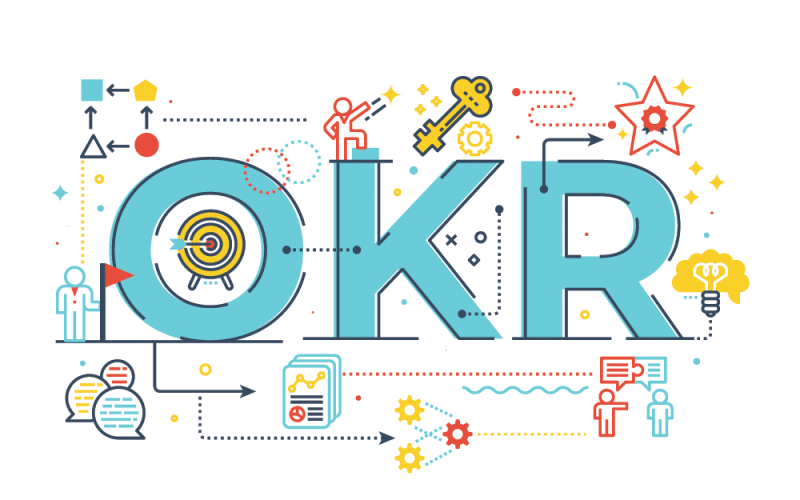While no one enjoys a work acronym, some are actually quite useful. Take, for example, OKRs – or Objectives and Key Results – which, when implemented correctly, can supercharge company development, health, and pleasure. OKRs are critical metrics for outlining your goals and how you intend to achieve them. But how do you go about doing so? And what tools can you employ to make the entire process of communicating with and tracking them as painless as possible? What are okrs in business? We’ll all that and also see the top 10 OKR tools for businesses in this article.
What are OKRs?
Importantly, OKRs are not just another piece of corporate jargon. They help organizations and teams set out strategies and goals in manageable chunks. However, you shouldn’t confuse them with KPIs (Key Performance Indicators). They serve as a reference to help you evaluate how well you performed concerning your goals. So, one can use them for anything from performance to productivity. OKRs are basically made up of two parts:
- Objectives – A qualitative, broad statement of what you hope to accomplish. For example, increasing company revenue by 10%.
- Key results – A quantitative, measurable outcome – often within a set timeframe – demonstrating how to meet that objective. For example, acquiring 100 new customers by Q3
Types Of OKRs
Generally, we can classify OKRs into 3 different types and are namely;
- Commited
- Aspiration
- Learning
The Advantages of OKRs
Have you ever been asked by management to set big, exciting goals at the start of the year, only to have them completely forgotten a few months later? OKRs are a direct result of this. They help you measure progress and keep everyone aligned within more reasonable timelines. They do this by breaking down the enormity of traditional company goal-setting. Also, they assist business executives to keep their overall corporate vision at the forefront of everyone’s mind. Thus it allows them to work with purpose — they see the big picture of what they’re working towards.
Finally, OKRs can assist you in your business in the following ways:
- Set goals that are both effective and obvious.
- Goal-setting can help to increase involvement and empowerment.
- Define and assess team performance concerning certain goals.
- Improve communication between management and teams.
- Improve the sense of shared accountability, transparency, and purpose.
Top 10 OKR Tools for Businesses
This all sounds fantastic, but you shouldn’t have to devote extra effort and resources to determine how well you’re performing in relation to your goals. OKRs are designed to make things simple. To make the process easier – and to ensure that everyone understands what is expected of them and how they are performing against those expectations – use one of these simple OKR tools. Because you may set OKRs for nearly any aspect of your performance, these tools cover a wide range of applications.
#1. CultureAmp – For determining objectives
The first okr tools we will look at is cultureAmp. CultureAmp assists you in identifying critical linkages between performance and engagement and transforming insights into high-impact actions to create an optimal employee experience. It dissects what high-performing individuals have in common and extracts actionable information over an employee’s tenure with the company. This then allows you to establish common goals for your entire team to work toward.
#2. Koan – for keeping OKRs visible.
Secondly, we will look at Koan OKR tools. Koan is all about forming purposeful teams through well-defined OKRs. The tool connects each employee to a company’s goal, vision, and priorities. It also allows them to track progress via a dashboard and provide and receive direct feedback. Koan pushes you to reflect on the progress of your goals each week, making goal tracking an active part of your routine.
#3. Weekdone – for staying on schedule
Weekdone streamlines OKR by making goals accessible and enhancing transparency through interactive reporting. It eliminates the need for weekly stand-up meetings in favor of quick and easy online check-ins. So it allows employees to organize their day and week with the company’s mission in mind.
#4. Timely – for assessing team performance
Timely helps you develop OKRs and set new temporal goals by measuring how long it takes teams to complete specific tasks, such as aiming to build and QA a new homepage in two days or limiting the time you spend on daily email to 10 minutes. You may also quickly compare performance to monetary KPIs to try to improve your billable-to-non-billable ratio on projects. All project progress and staff performance can be tracked via real-time dashboards, including time spent on tasks and work versus capacity, as well as project budget spend.
#5. Perdoo – for establishing OKRs
Perdoo’s internal AI guides you through your OKR process step by step, assisting you to generate meaningful, logical objectives every time. Perdoo helps your objectives and results come to life with a visual hierarchy, allowing you to align your team to goals and update and amend in real-time, using a map structure to clearly navigate through them.
#6. Engagedly – in search of OKR inspiration
Engagedly is a robust tool for creating and tracking objectives, allowing you to lay them out and benchmark them with a customized check-in feature. They also provide template-based performance management, advising you on which objective is best for your team, which is useful if you’re not sure what to set out. With its progress indicators, you can also track the progress of each individual goal in a couple of seconds.
#7. SimpleOKR – for reviews and feedback
SimpleOKR delves deeply into goal-setting structures, allowing you to establish three to five high-level targets. This engages every member of your team and inspires them to make the necessary efforts to achieve those goals. You can define OKR targets for each team member and deliver 360-degree performance reviews for as little as $5 per user every month.
#8. Peoplegoal – used to track OKRs.
This is a tool that improves OKR accountability and traceability throughout your team by using a balanced scorecard method to set business objectives. Employees then match their personal ambitions with the company’s aims to visualize their contributions week after week. People goal also allows you to plan 1:1s and create particular discussion points, although these can also be generated automatically based on goal performance.
#9. ClickUp – for effective management of your OKRs.
ClickUp’s Goals feature lets you manage your team’s OKRs alongside your projects, tasks, and other work. ClickUp adds objectives as Goals, and significant outcomes are visualized as measurable numerical, monetary, or task-based Targets that exist within their associated Goals. Goals can be assigned to yourself or to numerous persons in a single aim. As you accomplish individual Targets, your progress toward the overall goal is shown as a percentage, making it simple to follow individual and team updates on OKRs. These Goals can also be arranged into folders, making it easy to group and track OKR progress by department, team, time period, and more.
#10 Wrike
This is also one OKR tools to look out for. Wrike is an OKR management software that is used by over 20,000 businesses globally. It uses Kanban boards, Gantt charts, time tracking, custom request forms with auto-assignment, performance reports, resource management, and allocation. It also uses automated reporting, and shared workflows all in one place, you can streamline your OKR administration. Wrike’s 400+ integrations will help you speed up your delivery. With Wrike, you can customize your team’s workflows to see progress at every step and guarantee your team meets its goals.
What are some best practices for OKR implementation?
Having a clear process for setting, tracking, and reviewing OKRs is crucial for success. It’s important to involve all stakeholders, set realistic and attainable objectives, and regularly reassess and adjust as needed. It’s also helpful to use technology to automate the process and make it easier to track progress.
How can OKRs be used to track progress towards company mission?
OKRs can be used to track progress towards company mission by breaking down larger goals into smaller, measurable objectives. This allows companies to see how they’re moving closer to their mission over time and make adjustments as needed.
How can OKRs be used to track progress towards company vision?
Similar to tracking progress towards company mission, OKRs can be used to track progress towards company vision. By breaking down vision into smaller, measurable objectives, companies can track progress and see how they’re moving towards realizing their vision over time.
How can OKRs be used for performance management?
OKRs can be used for performance management by setting performance-related objectives and regularly tracking progress. This can help companies identify areas for improvement and make adjustments as needed to ensure employees are meeting expectations and contributing to overall company success.
How often should you review your OKRs?
It’s recommended to review OKRs on a regular basis, such as quarterly or semi-annually. This allows for progress to be tracked and objectives to be adjusted as needed to ensure they remain realistic and attainable.
In conclusion
“Vision without execution is hallucination,” as Thomas Edison once said, and it is a principle that has greatly inspired Doerr and the OKR methodology: good ideas with poor implementation will always stay just that, ideas.
Goal setting, and by extension OKRs, according to Doerr, is the most powerful lever in execution. It directs our attention, promotes accountability, and emphasizes the tasks that truly drive success.
“When done correctly,” Doerr told Betterworks, “goal planning is a tremendously powerful tool.” “Every team member in the organization can connect personal ambitions to the corporate goals, understanding that their effort has a direct impact on the firm’s success.
What are Okrs FAQs
How do you explain OKRs to employees?
OKR results can be based on growth, performance, revenue, or engagement. They are often numerical, but they can also be presented as ‘done’ or ‘undone’ or graded with a binary system “0 or 1”. Using the Objective given in the last paragraph, a good Key Result would be to “Get 100 positive ratings in our support chat.”
What is the purpose of OKRs?
Objectives and key results (OKR) is a goal-setting framework that helps organizations define goals — or objectives — and then track the outcome. The framework is designed to help organizations establish far-reaching goals in days instead of months
Are OKRs useful?
Done perfectly, OKRs help companies align their goals and focus on the big picture. Each team knows what its objectives are and what are the measurable key results that will indicate the objective is being achieved – and the transparency of the process means all the other teams know, too.
How many OKRs are in a quarter?
We typically recommend setting a maximum of 3-5 OKRs per team per quarter. This is a maximum, not a minimum – it’s perfectly appropriate to have only 1-2 OKRs. What matters most is that you don’t pick a number and then let that dictate how many goals you need to achieve within the given timeframe







1 comment
I was surprise to not see Gtmhub on this list! Especially given the recent acquisition of Koan. Always looking to connect with others regarding OKRs on LinkedIn 🙂 – http://www.linkedin.com/in/stephen-darling-gtm